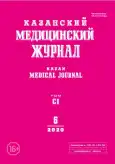Persons disabled since childhood with severe functional impairments: medical-social portrait
- Authors: Ishutina IS1, Vladimirova OA1, Afonina KP2, Khodakovskii MD1, Gerashchenko LI3, Kantemirov AS4
-
Affiliations:
- Federal Scientific Centre of Rehabilitation of the Disabled named after G.A. Albrecht
- The Ministry of Labour and Social Protection of the Russian Federation
- The Bonch-Bruevich Saint-Petersburg State University of Telecommunications
- Residential home for elderly and disabled people №1
- Issue: Vol 101, No 6 (2020)
- Pages: 869-875
- Section: Social hygiene and healthcare management
- Submitted: 05.09.2020
- Accepted: 29.09.2020
- Published: 14.12.2020
- URL: https://kazanmedjournal.ru/kazanmedj/article/view/43688
- DOI: https://doi.org/10.17816/KMJ2020-869
- ID: 43688
Cite item
Abstract
Aim. To study of medical and social characteristics of persons disabled since childhood of the first group, their needs for various types of rehabilitation and care for the development of a medical-social model of personal assistance.
Methods. A sample study of 194 persons disabled since childhood of the first group in eight regions of the Russian Federation was conducted using a specially developed methodology. The calculations were performed by using the IBM SPSS Statistics Viewer 23.
Results. The state of health of persons disabled since childhood of the first group is characterized by polymorphism and polymorbidity. 64.3% of people with disabilities have multiple dysfunctions of organs and systems. In this regard, there are pronounced restrictions on the main categories of life activity. Half of the caregivers (47.4%) spend more than 8 hours a day on organizing care for persons disabled since childhood of the first group; between 4 and 8 hours — 29.8%; between 2 and 3 hours — 12.9%; less than 2 hours — 4.1%. It was found that 32.7% of families spend more than half of their family budget on care (organization of medical and household care, transportation and relocation, organization of training, communication in accordance with age). At the same time, only 30.0% of caregivers work, the remaining 70.0% do not work (do not receive seniority) and will not be able to claim a labor pension. Persons disabled since childhood of the first group are characterized by pronounced restrictions on the main categories of life, the need for constant and regular care of all types, however, 28.4% of this group of people can self-service themselves or with little help from other people. With the presented medical-social portrait, state support for this category of citizens should be carried out in a differentiated manner. The “personal assistance” model allows parents/guardians of persons disabled since childhood of the first group not only to care for a family member but also to find employment as a personal assistant.
Conclusion. Families with persons disabled since childhood of the first group need differentiated support that will allow parents/guardians to care for their family members and work; the “personal assistance” model could solve these problems.
Full Text
About the authors
I S Ishutina
Federal Scientific Centre of Rehabilitation of the Disabled named after G.A. Albrecht
Email: hodak200@yandex.ru
Russian Federation, Saint Petersburg, Russia
O A Vladimirova
Federal Scientific Centre of Rehabilitation of the Disabled named after G.A. Albrecht
Email: hodak200@yandex.ru
Russian Federation, Saint Petersburg, Russia
K P Afonina
The Ministry of Labour and Social Protection of the Russian Federation
Email: hodak200@yandex.ru
Russian Federation, Moscow, Russia
M D Khodakovskii
Federal Scientific Centre of Rehabilitation of the Disabled named after G.A. Albrecht
Author for correspondence.
Email: hodak200@yandex.ru
Saint Petersburg, Russia
L I Gerashchenko
The Bonch-Bruevich Saint-Petersburg State University of Telecommunications
Email: hodak200@yandex.ru
Russian Federation, Saint Petersburg, Russia
A S Kantemirov
Residential home for elderly and disabled people №1
Email: hodak200@yandex.ru
Russian Federation, Saint Petersburg, Russia
References
- Decree of the President of the Russian Federation №204 of 07.05.2018 “On national goals and strategic objectives for the development of the Russian Federation for the period up to 2024”. (In Russ.)
- Goal 1: End poverty in all its forms everywhere. The Sustainable Development Goals UN. https://www.un.org/sustainabledevelopment/poverty/ (access date: 01.08.2020). (In Russ.)
- The total number of people with disabilities by disability group. Official website of the Federal State Statistics Service. https://www.gks.ru/folder/13964 (access date: 01.08.2020). (In Russ.)
- Number of people with disabilities due to disability reasons. Federal Register of Persons with Disabilities. https://sfri.ru/analitika/chislennost/chislennost/chislennost-po-prichinam?territory=1 (access date: 01.08.2020). (In Russ.)
- Article 19 of the UN Convention on the Rights of Persons with Disabilities. Adopted by the General Assembly at the Sixty-first Session, resolution 61/106, A/RES/61/106, 13 December 2006. (In Russ.)
- International classification of functioning, disabilities and health (ICF, WHO, 2001). Online reference book of health care and medicine ZdravMedInform. https://zdravmedinform.ru/icf.html (access date: 01.08.2020). (In Russ.)
- Order of the Ministry of Labor and Social Protection of the Russian Federation from August 27, 2019 №585n “On the classifications and criteria used in the implementation of the medical and social examination of citizens by federal state institutions of the medical and social examination”. https://www.garant.ru/products/ipo/prime/doc/72921006/ (access date: 01.08.2020). (In Russ.)
- Bakk A., Gryundeval'd K. Zabota i uhod: kniga o lyudyah s zaderzhkoj umstvennogo razvitiya. (Concern and care: A book about people with mental retardation.) Translation from Swedish. Ed. by Yu. Kolesovoj. SPb.: IRAV. 2001; 177–178. (In Russ.)
- Decree of the Government of the Republic of Moldova from 23.05.2012 №314 “On approval of the Model Regulations on the Organization and Functioning of the Social Service "Personal Assistant" and the Minimum Quality Standards”. State register of legal acts of the Republic of Moldova. https://www.legis.md/cautare/getResults?doc_id=84693&lang=ru (access date: 01.08.2020) (In Russ.)
- Last step. How can parents get funds to care for children with disabilities. IA “24.kg” — Novosti Kyrgystana. https://24.kg/obschestvo/102534_posledniy_shag_kak_roditelyam_poluchit_sredstva_pouhodu_zadetmi_sovz_/ (access date: 01.08.2020). (In Russ.)
Supplementary files








